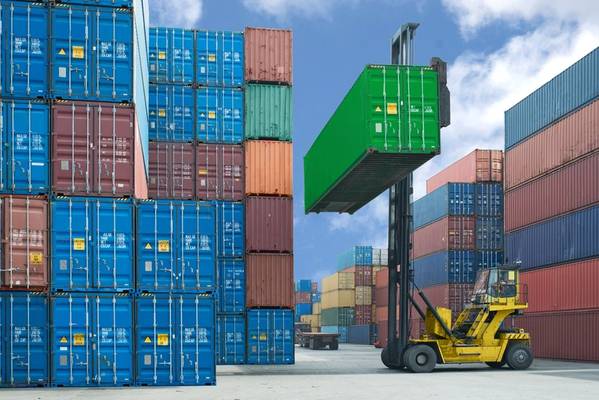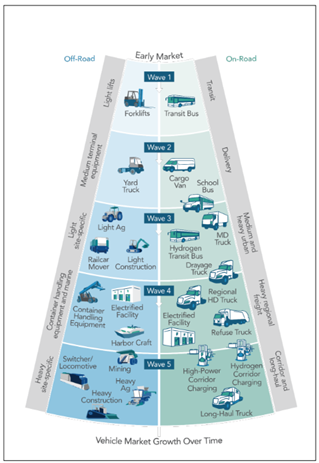
Ports are high-polluting environments, with lots of diesel-powered off-road vehicles in operation, working day and night. This makes the maritime industry a key player in the decarbonization of off-road transport, with companies and authorities seeking new ways to reduce emissions and encourage greater use of zero-carbon machines. Off-road electrification is progressing rapidly, particularly within certain categories of cargo handling, such as forklifts.
The need to tackle high port emissions
According to the U.S. Environmental Protection Agency (EPA), emissions from port operations expose millions of people living in close proximity to these operations to harmful levels of air pollution. Emissions associated with diesel engines have been linked to a range of serious health conditions, including heart and lung disease, cancer, and respiratory illnesses, particularly in younger and older people. This is in addition to the negative effects on the global climate made by CO2 from these diesel emissions.
Reducing maritime emissions levels is, therefore, a focus of zero-carbon efforts and agencies are looking at where zero-emission technology can best be used at ports, including the electrification of off-road vehicles. A study carried out in 2013 by the International Council on Clean Transportation (ICCT) discovered “the ports of Seattle/Tacoma and San Francisco have the highest rates in the [U.S.] of early deaths per 100,000 residents from port pollution, more than double the global average” (Stand.earth, 2022).
What options are there for electrification of port equipment?
Ports present a range of opportunities for electrification, with many of them being trialed by anchorages. Options include cargo-handling equipment such as yard trucks, forklifts, drayage trucks, and port cranes. One of the most effective opportunities for reducing emissions at ports is “cold ironing,” in which docked ships are powered from the shore by an electrical power source on the quayside, eliminating the need to run the diesel engines.
The cargo-handling equipment (CHE) category comprises off-road equipment, as well as equipment in intermodal rail yards or ports used to lift and move cargo, and sometimes that employed for repair or maintenance purposes. Many off-road vehicles in this category are suitable for electrification; some electrified versions, such as forklifts and yard trucks, are already in use.
Port electrification challenges still exist
According to the California Air Resources Board’s (CARB) 2022 Heavy-Duty Investment Strategy, infrastructure and cost are the two main market barriers for off-road equipment electrification (CARB, 2022). Charging infrastructure is essential to the success of electrification projects, and some heavy-duty equipment used at ports, such as some of the largest cranes, requires particularly high charging rates, which can involve specialist installation.
However, battery-swapping solutions and high-power charging, up to 1.5 megawatts, are being explored (McKinsey, 2019), while hydrogen fuel-cell options may offer an alternative to batteries, particularly if remote hydrogen generation can be developed. There are also ways of reducing the impact on productivity from slow charging downtime, including the installation of new, very large fast-charging systems, allowing for charging during loading and unloading or even during operation. Pantographs paired with renewable power generation can provide an ideal zero-carbon charging option, but are currently prohibitively expensive in most cases. There are also growing options for hybrid-electric technologies, which can offer improved efficiency and lower energy costs than traditional ICE vehicles.
The future of maritime electrification: the Beachhead Model
The Beachhead Model, conceptualized by CALSTART and CARB, attempts to provide some of the answers to challenges that remain when it comes to fully electrifying larger off-road equipment (CARB, 2022). It demonstrates that electrification of larger equipment and more difficult-to-electrify segments can be achieved and accelerated by using small-equipment electrification as a starting point.
 Visualization of Off-Road and On-Road Zero-Emission Equipment Implementation Progress Using the Beachhead Model Framework (CALSTART & CARB, 2022)The electrification of large fleets of compact equipment brings about key benefits that make the electrification of larger equipment more likely, including R&D spending in the electrified segment, expansion of charging infrastructure, and winning-over of employees or companies. Each wave of development has a ripple effect on the next and, from the diagram above, it can be seen that development of off-road electrification has already reached Wave 4.
Visualization of Off-Road and On-Road Zero-Emission Equipment Implementation Progress Using the Beachhead Model Framework (CALSTART & CARB, 2022)The electrification of large fleets of compact equipment brings about key benefits that make the electrification of larger equipment more likely, including R&D spending in the electrified segment, expansion of charging infrastructure, and winning-over of employees or companies. Each wave of development has a ripple effect on the next and, from the diagram above, it can be seen that development of off-road electrification has already reached Wave 4.
This process of electrifying larger off-road vehicles is expected to continue as batteries become faster, safer, more powerful, and less expensive (CALSTART & CARB, 2022). Progress is already leading to longer operating times, expanding the range of vehicles suitable for electrification, and demonstrating that electrifying heavy off-road equipment is achievable. The Beachhead strategy has proven successful in addressing the challenges of and eliminating key barriers to electrifying off-road equipment, with improvements in infrastructure at locations such as ports and airports expected to lead to wider implementation in the future.
Incentives will accelerate move to electrified ports
In the U.S., California is leading the way in the electrification of off-road vehicles, including those used at ports. California Governor Gavin Newsom’s 2021 Executive Order N-79-20 sets a deadline of 2035 for all sales of off-road equipment in California to shift entirely to zero-emission models. The ground-breaking state legislation is expected to influence electrification legislation, incentives, and uptake across North America. Related to this, California’s $273 million Clean Off-Road Equipment (CORE) Voucher Incentive Project, which covers a range of vehicle and equipment types, provides a discount on the sale or lease price of zero-emission equipment, with no scrappage requirement. There is also further CORE funding available for machines deployed in disadvantaged communities, and for charging and fueling infrastructure.
The U.S. is also seeing a growing body of national legislation aimed at promoting zero-emission machines, such as the Inflation Reduction Act of 2022, the Diesel Emission Reduction Act (DERA), and the U.S. National Blueprint for Transportation Decarbonization. Coupled with legislation, incentives will play a crucial role in offsetting the relatively high initial outlay for electrified off-road equipment purchases. For example, DERA’s objective is to fund cost-effective projects, such as equipment replacement and retrofits, targeted at communities disproportionately affected by emissions, such as those near ports.
San Pedro Bay Ports takes action to decarbonize
Comprising the Ports of Long Beach and Los Angeles, San Pedro Bay Ports has set an ambitious target of emission-free goods movement by 2030, with the infrastructure and equipment associated with the project expected to cost as much as $14 billion. The twin port complex’s 2021 clean air assessment revealed the four main categories of port equipment were dominated by ICE technology (San Pedro Bay Ports, 2021), including 1,615 yard tractors (80% powered by diesel engines), 560 forklifts (nearly 40% heavy-capacity diesels ), 159 RTG cranes (almost wholly powered by diesel engines), and 389 container handlers. It should be noted, however, that 23% of the cranes used advanced ICE/hybrid electric technology, which reduces emissions and delivers higher operational efficiency.
The figures from San Pedro Bay Ports demonstrate the potential for decarbonization of off-road vehicles in ports and the scale of work needed to move toward zero-emission powertrains. However, in the 2021 assessment, the ports authority also noted at least 20 pieces of battery-electric or fuel-cell electric cargo-handling equipment were either in full deployment or in the pilot stage, including yard tractors, container handlers, and large-capacity forklifts.
Batteries alone unlikely to deliver full decarbonization
As demonstrated by San Pedro Bay Ports, the path towards decarbonization of off-road vehicles in the maritime industry is unlikely to be achieved using battery power alone. There will undoubtedly be some types of heavy equipment used at ports that are not suitable for a purely electric option because of factors such as range, charging times, or power density.
In these cases, developments in hydrogen fuel-cell technology can provide the zero-emission solution required. In the U.S., the Department of Energy is allocating $8 billion for the development of “Hydrogen Hubs” across the country and some OEMs already have hydrogen fuel-cell off-road vehicles in the demonstration phase. Anticipated future developments in hydrogen refueling infrastructure could overcome some of the key technological barriers to adoption, although concerns remain about the cost and current carbon footprint of producing hydrogen fuel.
The path to decarbonization of maritime off-road vehicles
Electrification presents a range of benefits beyond significant environmental and health advantages. Because battery-electric equipment (Raftery, 2018) has around 20 parts in the drivetrain, compared with more than 2,000 parts for internal combustion engines, it requires near-zero maintenance and has almost no breakdowns. This in addition to reduced running costs and dramatically lower noise and vibration levels. In fact, repair and maintenance costs of battery-electric equipment is often almost half the price compared to corresponding ICE models (Office of Energy Efficiency and Renewable Energy, 2021).
Legislators, relevant agencies, and the maritime sector are all working together to encourage greater uptake of zero-emission off-road vehicles at ports. High levels of pollution and the health impact on those living near ports, as well as those ports’ heightened carbon-emissions levels, makes the maritime industry a key focus of efforts to decarbonize off-road transportation. In port cities and states such as California in particular, legislators are implementing measures to hasten the adoption of battery-electric, hybrid, and hydrogen fuel-cell vehicles.
References
California Air Resources Board (CARB) (2022). Long-Term Heavy-Duty Investment Strategy.
Stand.earth (2022a). On Earth Day, activists in 3 west coast cities rally against ocean shipping pollution. Retrieved from link.
Tessum, C., Paolella, D., Chambliss, S., Apte, J., Hill, J., & Marshall, J. (2021).
California Air Resources Board (CARB) (2021). California Greenhouse Gas Emissions for 2000 to 2019: Trends of Emissions and Other Indicators. Retrieved from link.
CARB (2022). Long-Term Heavy-Duty Investment Strategy.
CALSTART and CARB (2022). Technology and Market Assessment of Zero-Emission Off-Road Equipment.
Clean Off-Road Equipment Voucher Incentive Project (2022). California CORE Voucher Funding Map. Retrieved from link.
Hayfield, Alastair & Zhang, Jan (2021). Interact Analysis. Off Highway Vehicles – 2021. Retrieved from link.
McKinsey (2019). Harnessing Momentum for electrification in heavy machinery and equipment, Retrieved from link.
Newsom, Gavin (2020). State of California Executive Department. Executive Order N79-20. Retrieved from link.
Office of Energy Efficiency and Renewable Energy (2021). Battery-electric vehicles have lower scheduled maintenance costs than other light-duty vehicles. Retrieved from link.
San Pedro Bay Ports (2022). Clean air action plan, 2021 update. Retrieved from link.
Stand.earth (2022). On Earth Day, activists in 3 west coast cities rally against ocean shipping pollution. Retrieved from link.
Tessum, C., Paolella, D., Chambliss, S., Apte, J., Hill, J., & Marshall, J. (2021). S Raftery, Tom (2018). Seven Reason Why The Internal Combustion Engine Is A Dead Man Walking [Updated]. Forbes. Retrieved from link.



